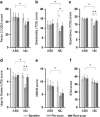Elevation of dopamine induced by cigarette smoking: novel insights from a [11C]-+-PHNO PET study in humans
- PMID: 23954846
- PMCID: PMC3870776
- DOI: 10.1038/npp.2013.209
Elevation of dopamine induced by cigarette smoking: novel insights from a [11C]-+-PHNO PET study in humans
Abstract
Positron emission tomography (PET) has convincingly provided in vivo evidence that psychoactive drugs increase dopamine (DA) levels in human brain, a feature thought critical to their reinforcing properties. Some controversy still exists concerning the role of DA in reinforcing smoking behavior and no study has explored whether smoking increases DA concentrations at the D3 receptor, speculated to have a role in nicotine's addictive potential. Here, we used PET and [(11)C]-(+)-PHNO ([(11)C]-(+)-4-propyl-3,4,4a,5,6,10b-hexahydro-2H-naphtho[1,2-b][1,4]oxazin-9-ol) to test the hypothesis that smoking increases DA release (decreases [(11)C]-(+)-PHNO binding) in D2-rich striatum and D3-rich extra-striatal regions and is related to craving, withdrawal and smoking behavior. Ten participants underwent [(11)C]-(+)-PHNO scans after overnight abstinence and after smoking a cigarette. Motivation to smoke (smoking topography), mood, and craving were recorded. Smoking significantly decreased self-reported craving, withdrawal, and [(11)C]-(+)-PHNO binding in D2 and D3-rich areas (-12.0 and -15.3%, respectively). We found that motivation to smoke (puff rate) predicted magnitude of DA release in limbic striatum, and the latter was correlated with decreased craving and withdrawal symptoms. This is the first report suggesting that, in humans, DA release is increased in D3-rich areas in response to smoking. Results also support the preferential involvement of the limbic striatum in motivation to smoke, anticipation of pleasure from cigarettes and relief of withdrawal symptoms. We propose that due to the robust effect of smoking on [(11)C]-(+)-PHNO binding, this radiotracer represents an ideal translational tool to investigate novel therapeutic strategies targeting DA transmission.
Figures




Similar articles
-
A Preliminary Investigation of the Effect of Acute Alcohol on Dopamine Transmission as Assessed by [11 C]-(+)-PHNO.Alcohol Clin Exp Res. 2017 Jun;41(6):1112-1119. doi: 10.1111/acer.13403. Epub 2017 May 29. Alcohol Clin Exp Res. 2017. PMID: 28421623 Clinical Trial.
-
Higher binding of the dopamine D3 receptor-preferring ligand [11C]-(+)-propyl-hexahydro-naphtho-oxazin in methamphetamine polydrug users: a positron emission tomography study.J Neurosci. 2012 Jan 25;32(4):1353-9. doi: 10.1523/JNEUROSCI.4371-11.2012. J Neurosci. 2012. PMID: 22279219 Free PMC article.
-
Decreased binding of the D3 dopamine receptor-preferring ligand [11C]-(+)-PHNO in drug-naive Parkinson's disease.Brain. 2009 May;132(Pt 5):1366-75. doi: 10.1093/brain/awn337. Epub 2009 Jan 19. Brain. 2009. PMID: 19153147
-
[11C](+)-4-N-Propyl-,3,4a,5,6,10b-hexahydro-2H-naphth[1,2-b][1,4]-oxazin-9-ol.2006 May 2 [updated 2011 Oct 6]. In: Molecular Imaging and Contrast Agent Database (MICAD) [Internet]. Bethesda (MD): National Center for Biotechnology Information (US); 2004–2013. 2006 May 2 [updated 2011 Oct 6]. In: Molecular Imaging and Contrast Agent Database (MICAD) [Internet]. Bethesda (MD): National Center for Biotechnology Information (US); 2004–2013. PMID: 20641608 Free Books & Documents. Review.
-
Toward whole-brain dopamine movies: a critical review of PET imaging of dopamine transmission in the striatum and cortex.Brain Imaging Behav. 2019 Apr;13(2):314-322. doi: 10.1007/s11682-017-9779-7. Brain Imaging Behav. 2019. PMID: 29071465 Free PMC article. Review.
Cited by
-
Functional Genetic Variation in Dopamine Signaling Moderates Prefrontal Cortical Activity During Risky Decision Making.Neuropsychopharmacology. 2016 Feb;41(3):695-703. doi: 10.1038/npp.2015.192. Epub 2015 Jun 29. Neuropsychopharmacology. 2016. PMID: 26119471 Free PMC article.
-
Brain substrates of early (4h) cigarette abstinence: Identification of treatment targets.Drug Alcohol Depend. 2018 Jan 1;182:78-85. doi: 10.1016/j.drugalcdep.2017.10.010. Epub 2017 Nov 20. Drug Alcohol Depend. 2018. PMID: 29172122 Free PMC article.
-
Food Addiction and Tobacco Use Disorder: Common Liability and Shared Mechanisms.Nutrients. 2020 Dec 15;12(12):3834. doi: 10.3390/nu12123834. Nutrients. 2020. PMID: 33334010 Free PMC article. Review.
-
Striatal Dopamine Release in Response to Morphine: A [11C]Raclopride Positron Emission Tomography Study in Healthy Men.Biol Psychiatry. 2019 Sep 1;86(5):356-364. doi: 10.1016/j.biopsych.2019.03.965. Epub 2019 Mar 15. Biol Psychiatry. 2019. PMID: 31097294 Free PMC article.
-
The influence of conditioned stimuli on [11C]-(+)-PHNO PET binding in tobacco smokers after a one week abstinence.Sci Rep. 2021 Jun 3;11(1):11667. doi: 10.1038/s41598-021-90915-y. Sci Rep. 2021. PMID: 34083612 Free PMC article.
References
-
- Andreoli M, Tessari M, Pilla M, Valerio E, Hagan JJ, Heidbreder CA. Selective antagonism at dopamine D3 receptors prevents nicotine-triggered relapse to nicotine-seeking behavior. Neuropsychopharmacology. 2003;28:1272–1280. - PubMed
-
- Barrett SP, Boileau I, Okker J, Pihl RO, Dagher A. The hedonic response to cigarette smoking is proportional to dopamine release in the human striatum as measured by positron emission tomography and [11C]raclopride. Synapse. 2004;54:65–71. - PubMed
-
- Beck AT, Steer RA. Beck Depression Inventory. Center for Cognitive Therapy: Philadelphia, PA, USA; 1997.
-
- Bernert JT, Jr., Turner WE, Pirkle JL, Sosnoff CS, Akins JR, Waldrep MK, et al. Development and validation of sensitive method for determination of serum cotinine in smokers and nonsmokers by liquid chromatography/atmospheric pressure ionization tandem mass spectrometry. Clin Chem. 1997;43:2281–2291. - PubMed
Publication types
MeSH terms
Substances
Grants and funding
LinkOut - more resources
Full Text Sources
Other Literature Sources
Medical

